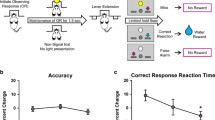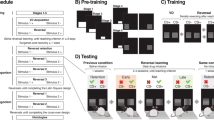Abstract
Latent inhibition (LI) is the delayed learning of an association when the conditioned stimulus has previously been experienced out of the context of that association. LI can be measured across species and has been used to understand the neurobiology of schizophrenia, since some reports suggest that schizophrenia patients exhibit LI deficits. One challenge of LI studies in humans has resulted from the fact that LI paradigms have almost uniformly involved between-subject comparisons. We now report a new within-subject paradigm that detected LI in normal adult male subjects after ingestion of a placebo. After amphetamine (20 mg p.o.) or bromocriptine (1.25 mg p.o.), LI was not evident, suggesting that the LI detected by this paradigm is sensitive to disruption by dopamine agonists. The apparent advantages and limitations of this paradigm are discussed with regard to its future use in understanding the neural basis of reported LI deficits in schizophrenia.




Similar content being viewed by others
References
Abduljawad KAJ, Langley RW, Bradshaw CM, Szabadi E (1997) Evidence for involvement of D2 dopamine receptors in prepulse inhibition of the startle reflex in man. Psychopharmacology 11:69
Abduljawad KA, Langley RW, Bradshaw CM, Szabadi E (1998) Effects of bromocriptine and haloperidol on prepulse inhibition of the acoustic startle response in man. Psychopharmacology 12:239–245
Baruch I, Hemsley DR, Gray JA (1988a) Differential performance of acute and chronic schizophrenics in a latent inhibition task. J Nerv Ment Disord 176:598–606
Baruch I, Hemsley DR, Gray JA (1988b) Latent inhibition and "psychotic proneness" in normal subjects. Pers Individ Diff 9:777–783
Bond AJ, Lader MH (1974) The use of analogue scales in rating subjective feelings. Br J Med Psychol 47:211–218
Braff DL, Freedman R (2002) Endophenotypes in studies of the genetics of schizophrenia. In: Davis KL, Charney D, Coyle JT, Nemeroff C (eds) ACNP 5th Generation of progress. Lippincott Williams & Wilkins, Philadelphia, pp 703–716
Bunney WE Jr, Hetrick WP, Bunney BG, Patterson JV, Jin Y, Potkin SG, Sandman CA (1999) Structured interview for assessing perceptual anomalies (SIAPA). Schizophr Bull 25:577–952
Casa LG de la, Lubow RE (2001) Latent inhibition with a response time measure from a within-subject design: effects of number of preexposures, masking task, context change and delay. Neuropsychology 15:244–253
Casa LG de la, Lubow RE (2002) An empirical analysis of the super-latent inhibition effect. Anim Learn Beh 30:112–120
Cloninger CR, Przybeck TR, Svrakic DM (1991) The tridimensional personality questionnaire: U.S. normative data. Psychol Rep 69:1047–1057
Cohen J (1988) Statistical power analysis for the behavioral sciences, 2nd edn. Lawrence Erlbaum, Hillsdale
First MB, Spitzer RL, Gibbon M, Williams JBW (1997) Structured clinical interview for DSM-IV axis I disorders, research version, non-patient edition (SCID-I/NP). Biometrics Research, New York
Gray JA (1998) Integrating schizophrenia. Schizophr Bull 24:249–266
Gray NS, Hemsley DR, Gray JA (1992a) Abolition of latent inhibition in acute, but not chronic schizophrenics. Neurol Psychiatry Brain Res 1:1–7
Gray NS, Pickering AD, Hemsley DR et al (1992b) Abolition of latent inhibition by a single 5-mg dose of d-amphetamine in man. Psychopharmacology 107:425–430
Hutchison KE, Wood MD, Swift R (1999) Personality factors moderate subjective and psychophysiological responses to d-amphetamine in humans. Exp Clin Psychopharmacol 7:493–501
Lubow RE (1973) Latent inhibition. Psychol Bull 79:398–407
Lubow RE, Moore AU (1959) Latent inhibition: the effect of nonreinforced exposure to the conditioned stimulus. J Comp Physiol Psychol 52:415–419
Lubow RE, De la Casa G (2002) Latent inhibition as a function of schizotypality and gender: implications for schizophrenia. Biol Psychol 59:6986
Lubow RE, Weiner I, Schlossberg A, Baruch I (1987) Latent inhibition and schizophrenia. Bull Psychon Soc 25:464467
Norris H (1971) The action of sedation on brain-stem oculomotor systems in man. Neuropharmacology 10:181–191
Swerdlow NR, Braff DL, Hartston H, Perry W, Geyer MA (1996) Latent inhibition in schizophrenia. Schizophr Res 20:91–103
Swerdlow NR, Hartston HJ, Hartman P (1999) Enhanced visual latent inhibition in obsessive compulsive disorder. Biol Psychiatry 45:482–488
Swerdlow NR, Eastvold A, Gerbranda T, Uyan KM, Hartman P, Doan Q, Auerbach P (2000) Effects of caffeine on sensorimotor gating of the startle reflex in normal control subjects: impact of caffeine intake and withdrawal. Psychopharmacology 151:368–378
Swerdlow NR, Stephany N, Ross L, Wasserman L, Talledo J, Shoemaker J, Geyer MA, Cadenhead K, Auerbach PP (2001) Convergence and divergence of dopamine agonist effects on inhibitory measures across species. Proc Am Coll Neuropsychopharmacology, Waikoloa, HI, p 158
Swerdlow NR, Eastvold A, Karban B, Ploum Y, Stephany N, Geyer MA, Cadenhead K, Auerbach PP (2002a) Dopamine agonist effects on startle and sensorimotor gating in normal control subjects: time course studies. Psychopharmacology 161:189–201
Swerdlow NR, Stephany N, ShoemakerJM, Ross L, Wasserman LC, Talledo J, Auerbach PP (2002b) Effects of amantadine and bromocriptine on startle and sensorimotor gating: parametric studies and cross-species comparisons. Psychopharmacology 164:82–92
Weiner I, Lubow RE, Feldon J (1987) Disruption of latent inhibition by acute administration of low doses of amphetamine. Pharmacol Biochem Behav 30:871–878
Weiner I, Shofel A, Feldon J (1990) Disruption of latent inhibition by low dose of amphetamine is antagonized by haloperidol and apomorphine. J Psychopharmacol 4:255
Weiner I, Shadach E, Tarrasch R, Kidron R, Feldon J (1996) The latent inhibition model of schizophrenia: further validation using the atypical neuroleptic, clozapine. Biol Psychiatry 40:834–843
Williams JH, Wellman NA, Geaney DP, Cowen PJ, Feldon J, Rawlins JNP (1998) Reduced latent inhibition in people with schizophrenia: an effect of psychosis or of its treatment. Br J Psychiatry 172:243249
Acknowledgements
Studies were supported by MH59803 and MH01436. The authors gratefully acknowledge Dr. Kristin Cadenhead for providing medical coverage, and Dr. Mark Geyer for formative discussions.
Author information
Authors and Affiliations
Corresponding author
Rights and permissions
About this article
Cite this article
Swerdlow, N.R., Stephany, N., Wasserman, L.C. et al. Dopamine agonists disrupt visual latent inhibition in normal males using a within-subject paradigm. Psychopharmacology 169, 314–320 (2003). https://doi.org/10.1007/s00213-002-1325-6
Received:
Accepted:
Published:
Issue Date:
DOI: https://doi.org/10.1007/s00213-002-1325-6




